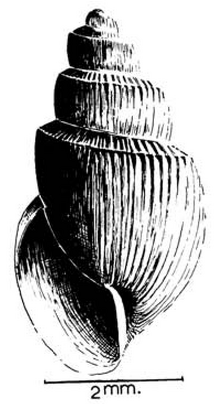Bulinus forskalii
| Bulinus forskalii | |
|---|---|

| |
| an apertural view of the shell of Bulinus forskalii | |
| Scientific classification | |
| Domain: | Eukaryota |
| Kingdom: | Animalia |
| Phylum: | Mollusca |
| Class: | Gastropoda |
| Subclass: | Heterobranchia |
| Superorder: | Hygrophila |
| Family: | Planorbidae |
| Genus: | Bulinus |
| Species: | B. forskalii
|
| Binomial name | |
| Bulinus forskalii (Ehrenberg, 1831)
| |
| Synonyms[1] | |
| |
Bulinus forskalii is a species of tropical freshwater snail with a sinistral shell, an aquatic gastropod mollusk in the family Bulinidae, the ramshorn snails and their allies.[2]
Distribution
Bulinus forskalii is an afrotropical[1] species which occurs in number of countries in Africa:
- Northern Africa: only in Egypt and Sudan.[1]
- Western Africa: Benin,[3] Burkina Faso, Côte d'Ivoire, Gambia, Ghana, Guinea, Guinea-Bissau, Liberia, Mali, Niger, Senegal[4] and Togo.[1]
- Eastern Africa: Burundi, Ethiopia, Kenya, Malawi, Mozambique, Somalia, Tanzania, Zambia and Zimbabwe.[1]
- Central Africa: Angola, Cameroon, Central African Republic, Chad, Democratic Republic of the Congo, Republic of the Congo, Equatorial Guinea and Gabon.[1] An extreme variant of Bulinus forskalii lives also on São Tomé Island.[5]
- Southern Africa: South Africa and Eswatini.[1]
This species has been recently introduced to Madagascar.[6]
Its presence is uncertain in Mauritania, Nigeria and in Sierra Leone.[1]
Ecology
The natural habitats for this species are lake margins, swamps, marshes and wetland areas.[1] It lives in all types of freshwater bodies and it has been found mainly in dams and brooks in South Africa.[7] The substratum is often muddy.[7]
Bulinus forskalii is a hermaphroditic species.[8] Self-fertilization can occur.[9]
Parasites of Bulinus forskalii include:
- as intermediate host for Schistosoma guineensis[8]
- as intermediate host for Schistosoma intercalatum[5]
- as intermediate host for Schistosoma haematobium – experimental infection in Niger,[10] but incompatible in South Africa[7]
- as intermediate host for Gastrodiscus aegyptiacus,[7] that causes gastrodiscosis in horses[11]
- three species of paramphistomes (superfamily Paramphistomoidea)[12]
It has been found incompatible with Schistosoma mattheei in South Africa.[7]
References
- ^ a b c d e f g h i j Albrecht, C.; Clewing, C.; Lange, C. (2018). "Bulinus forskalii". IUCN Red List of Threatened Species. 2018: e.T165794A120113860. doi:10.2305/IUCN.UK.2018-2.RLTS.T165794A120113860.en.
- ^ MolluscaBase eds. (2020). MolluscaBase. Bulinus forskalii (Ehrenberg, 1831). Accessed through: World Register of Marine Species at: http://www.marinespecies.org/aphia.php?p=taxdetails&id=1058686 on 2020-06-27
- ^ Ibikounlé, M.; Mouahid, G.; Sakiti, N. G.; Massougbodji, A.; Moné, H. (2009). "Freshwater snail diversity in Benin (West Africa) with a focus on human schistosomiasis". Acta Tropica. 111 (1): 29–34. doi:10.1016/j.actatropica.2009.02.001. PMID 19426659.
- ^ (in French) Sarr A., Kinzelbach R. & Diouf M. (2011, in press). "Diversité spécifique et écologie des mollusques continenatux de la basse vallée du Ferlo (Sénégal). [Specific diversity and ecology of continental molluscs from the Lower Ferlo Valley (Senegal)]". MalaCo 7: 8 pp. PDF Archived 2 October 2011 at the Wayback Machine.
- ^ a b Brown, D. S. (1991). "Freshwater snails of São Tomé, with special reference to Bulinus forskalii (Ehrenberg), host of Schistosoma intercalatum". Hydrobiologia. 209 (2): 141–153. doi:10.1007/BF00006926.
- ^ Stothard, J. R.; Brémond, P.; Andriamaro, L.; Sellin, B.; Sellin, E.; Rollinson, D. (2003). "Bulinus species on Madagascar: Molecular evolution, genetic markers and compatibility with Schistosoma haematobium". Parasitology. 123 (7): S261–75. doi:10.1017/S003118200100806X. PMID 11769288.
- ^ a b c d e De Kock, K. N.; Wolmarans, C. T. (2005). "Distribution, habitats and role as intermediate host of the freshwater snail, Bulinus forskalii, in South Africa". Onderstepoort Journal of Veterinary Research. 72 (2): 165–174. doi:10.4102/ojvr.v72i2.214. PMID 16137134.
- ^ a b Gow, J. L.; Noble, L. R.; Rollinson, D.; Mimpfoundi, R.; Jones, C. S. (2004). "Breeding system and demography shape population genetic structure across ecological and climatic zones in the African freshwater snail, Bulinus forskalii (Gastropoda, Pulmonata), intermediate host for schistosomes". Molecular Ecology. 13 (11): 3561–3573. doi:10.1111/j.1365-294X.2004.02339.x. PMID 15488012.
- ^ Gow, J. L.; Noble, L. R.; Rollinson, D.; Jones, C. S. (2005). "A high incidence of clustered microsatellite mutations revealed by parent-offspring analysis in the African freshwater snail, Bulinus forskalii (Gastropoda, Pulmonata)". Genetica. 124 (1): 77–83. doi:10.1007/s10709-005-0204-6. PMID 16011005.
- ^ Labbo, R.; Djibrilla, A.; Zamanka, H.; Garba, A.; Chippaux, J. -P. (2007). "Bulinus forskalii: A new potential intermediate host for Schistosoma haematobium in Niger". Transactions of the Royal Society of Tropical Medicine and Hygiene. 101 (8): 847–848. doi:10.1016/j.trstmh.2007.03.016. PMID 17568645.
- ^ Mukaratirwa, S.; Munjere, I. F.; Takawira, M.; Chingwena, G. (2004). "Susceptibility of 7 freshwater gastropod species in Zimbabwe to infection with Gastrodiscus aegyptiacus (Cobbold, 1876) Looss, 1896". Journal of the South African Veterinary Association. 75 (4): 186–188. doi:10.4102/jsava.v75i4.481. PMID 15830604.
- ^ Lotfy, W. M.; Brant, S. V.; Ashmawy, K. I.; Devkota, R.; Mkoji, G. M.; Loker, E. S. (2010). "A molecular approach for identification of paramphistomes from Africa and Asia". Veterinary Parasitology. 174 (3–4): 234–240. doi:10.1016/j.vetpar.2010.08.027. PMID 20880634.
External links
![]() Media related to Bulinus forskalii at Wikimedia Commons
Media related to Bulinus forskalii at Wikimedia Commons

